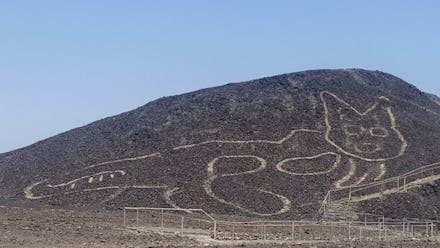The internet's new favorite cat is 2,000 years old and etched into the side of a hill

Researchers in Peru have made a surprising, and adorable, discovery on a desert hillside — a giant, prehistoric etching of a relaxed cat. Located in a UNESCO World Heritage site, the cat is one of many Nazca Lines found in the region that depict geoglyphs of creatures such as birds and human-like beings through etchings spanning several kilometers long. Scientists estimate the cat was created somewhere between 200 B.C. and 100 B.C., making it around 2000 years old.
While tourists have stayed home due to the pandemic, archaeologists have been continuing maintenance on these precious images. As they cleaned a sand mound, they realized there were lines that gradually revealed the familiar shape of a cat.
"The figure was scarcely visible and was about to disappear because it's situated on quite a steep slope that's prone to the effects of natural erosion," stated Peru's culture ministry in a press release. "Over the past week, the geoglyph was cleaned and conserved, and shows a feline figure in profile, with its head facing the front."
The lounging cat geoglyph is about 37 meters long; sports a long tail; and has big, googly kitty eyes. Each line is about 30 to 40 centimeters in thickness.
Nazca Lines are a fascinating mystery that have sparked curiosity and theories about alien contact for decades. They're made by digging out the top layer of dirt to expose the sandy-colored layer below. The lack of wind and rain in the area would preserve the differing colors as well as the drawing. Researchers believe the gigantic sketches were made by people of the ancient Nazca civilization.
Many of these lines can only be seen from afar, typically by plane, where one can see images of animals like the condor.
Experts are still trying to figure out why such large images were drawn on the Earth. The first few theories suspected they had something to do with astronomy. Later theories claimed the drawings pointed to sources of water and crops.
Modern theories postulate the pictures as parts of rituals making requests to ancient Gods. The images used are similar to other, much smaller, themes found on other ancient Peruvian land.
More and more lines continue to pop up as archaeologists tend to the area. Some of them can be difficult to recognize unless there's a good, long-distance shot of them.
"It's quite striking that we're still finding new figures, but we also know that there are more to be found," Johny Isla, Peru's chief archaeologist, told Spanish news agency Efe.
With the help of drones and satellite technology, hopefully more will be discovered before they're lost to erosion.